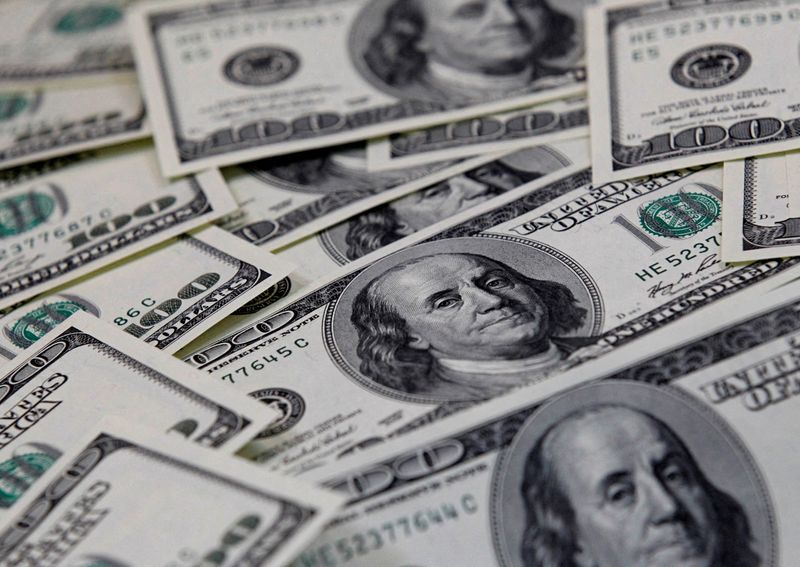Forex
Dollar gains after mixed jobs report


© Reuters. FILE PHOTO: U.S. one hundred dollar notes are seen in this picture illustration taken in Seoul February 7, 2011. REUTERS/Lee Jae-Won/File Photo
By Karen Brettell
NEW YORK (Reuters) – The dollar gained against the euro and Japanese yen on Friday after the August jobs report showed a still strong labor market, despite some signs of deterioration.
Employers added 187,000 jobs in August, above expectations for a 170,000 gain. But data for July was revised lower to show 157,000 jobs added instead of the previously reported 187,000.
The unemployment rate rose to 3.8%, above the expected 3.5%. Average hourly earnings rose by 4.3% for the year, below expectations for a 4.4% gain.
“Today’s jobs report provides investors the best of both worlds. It’s the labor market softening just enough to keep the Fed at bay while it’s strong enough to prevent an economic recession,” said Michael Arone, chief investment strategist at State Street (NYSE:) Global Advisors in Boston.
The was last up 0.58% at 104.23. It is up 0.08% on the week, overcoming price drops earlier in the week caused by softening economic data.
The euro fell 0.59% to $1.0779, down 0.13% on the week against the U.S. currency.
The greenback rose 0.42% to 146.145 Japanese yen, after earlier falling to 144.44, the lowest since Aug. 11. It is down 0.12% on the week after dropping from a 10-month high of 147.375 on Tuesday.
Fed funds futures traders are now pricing in a 93% likelihood that the Federal Reserve will leave rates unchanged at its September meeting and see only a 36% chance of a hike in November, according to the CME Group’s (NASDAQ:) FedWatch Tool.
Fed Bank of Cleveland President Loretta Mester said on Friday that the U.S. labor market remains strong despite signs of it coming into better balance, while noting future interest rate decisions will be made based on incoming data.
Some special circumstances impacted Friday’s jobs report. A strike by Hollywood actors resulted in a decrease of 17,000 jobs in the motion picture and sound recording industries last month. The bankruptcy of trucking firm Yellow (OTC:) in early August led to 37,000 job losses in the truck transportation industry.
Without these one-time drags, payrolls would have increased by about 241,000 in August.
Thomas Simons, a money market economist at Jefferies, noted that it was “overall, a strong month ex-Yellow,” but added that its “hard to get excited given the downward revisions”.
Other data on Friday showed that U.S. manufacturing contracted for a 10th straight month in August, but the pace of decline continued to slow, suggesting that the sector could be stabilizing at lower levels.
Elsewhere, European Central Bank policymaker Boris Vujcic said on Friday that weaker economic growth could bring euro zone inflation down faster, but a resilient labor market continues to produce quick wage growth, creating upside risk for prices.
ECB policymaker Francois Villeroy de Galhau also said that the ECB has a range of options at its next interest rate meeting, although interest rates are near their high point and there are signs underlying inflation has peaked.
Money markets are pricing in a 79% likelihood that the ECB will leave rates unchanged at its September meeting.
========================================================
Currency bid prices at 3:00PM (1900 GMT)
Description RIC Last U.S. Close Pct Change YTD Pct High Bid Low Bid
Previous Change
Session
Dollar index 104.2300 103.6300 +0.58% 0.715% +104.2700 +103.2600
Euro/Dollar $1.0779 $1.0843 -0.59% +0.59% +$1.0882 +$1.0775
Dollar/Yen 146.1450 145.5450 +0.42% +11.48% +146.2850 +144.4400
Euro/Yen 157.53 157.80 -0.17% +12.28% +157.9600 +157.0600
Dollar/Swiss 0.8853 0.8834 +0.23% -4.25% +0.8863 +0.8796
Sterling/Dollar $1.2593 $1.2672 -0.63% +4.12% +$1.2712 +$1.2578
Dollar/Canadian 1.3600 1.3509 +0.68% +0.38% +1.3613 +1.3490
Aussie/Dollar $0.6451 $0.6485 -0.53% -5.37% +$0.6521 +$0.6439
Euro/Swiss 0.9540 0.9576 -0.38% -3.56% +0.9582 +0.9542
Euro/Sterling 0.8557 0.8554 +0.04% -3.25% +0.8573 +0.8549
NZ $0.5943 $0.5966 -0.39% -6.40% +$0.6015 +$0.5935
Dollar/Dollar
Dollar/Norway 10.6680 10.6260 +0.46% +8.77% +10.6860 +10.5460
Euro/Norway 11.5022 11.5270 -0.22% +9.61% +11.5518 +11.4520
Dollar/Sweden 11.0422 10.9484 +0.22% +6.10% +11.0572 +10.8956
Euro/Sweden 11.9027 11.8764 +0.22% +6.75% +11.9261 +11.8566

 Forex3 years ago
Forex3 years agoForex Today: the dollar is gaining strength amid gloomy sentiment at the start of the Fed’s week

 Forex3 years ago
Forex3 years agoUnbiased review of Pocket Option broker

 Forex3 years ago
Forex3 years agoDollar to pound sterling exchange rate today: Pound plummeted to its lowest since 1985

 Forex3 years ago
Forex3 years agoHow is the Australian dollar doing today?

 Cryptocurrency3 years ago
Cryptocurrency3 years agoWhat happened in the crypto market – current events today

 World3 years ago
World3 years agoWhy are modern video games an art form?

 Commodities3 years ago
Commodities3 years agoCopper continues to fall in price on expectations of lower demand in China

 Economy3 years ago
Economy3 years agoCrude oil tankers double in price due to EU anti-Russian sanctions


























